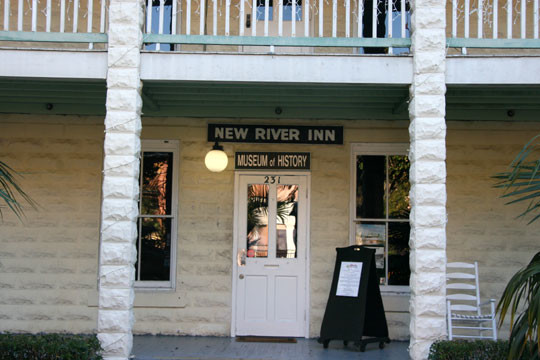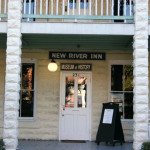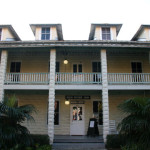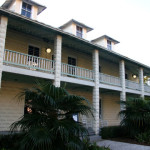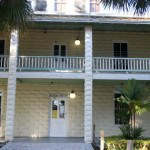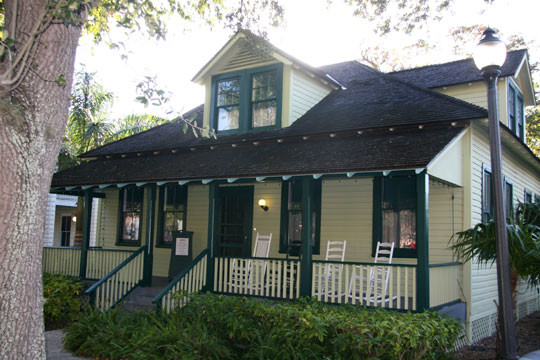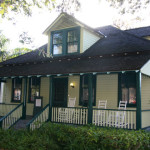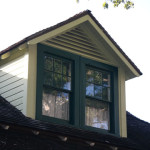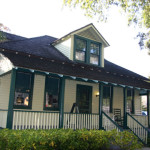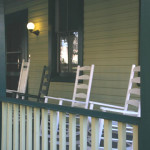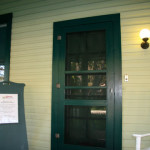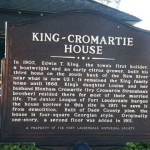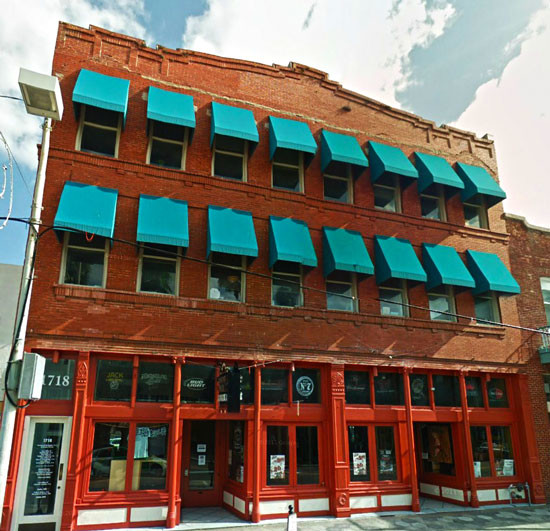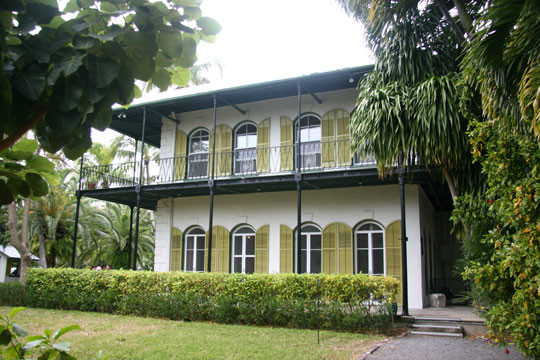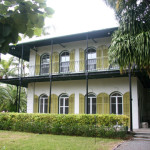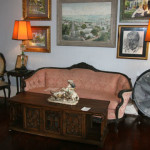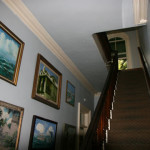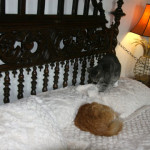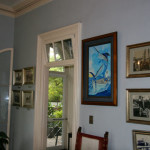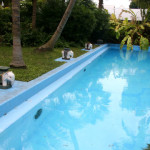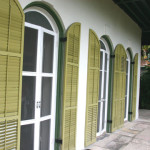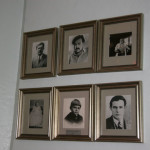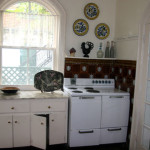
The house at 716 Dauphine Street is a classic French Quarter beauty with classic wrought-iron balconies and a large courtyard. But in the 1800s, this residence was a house of horrors for the Sultan, a wealthy man with a depraved lifestyle, multiple wives and children and a harem of women and young boys held against their will. Neighbors complained about the mysterious habits of this man who had a predilection for partying, opium and torture. But the greatest mystery in the house was the Sultan’s demise when he was buried alive in the courtyard after his family and harem were hacked to pieces in a bloodbath by an unknown perpetrator. Today, his angry spirit is thought to be responsible for the unusual noises, loud music and strong incense smells that waft from the home, as well as unwelcomed advances on past female residents who swear the Sultan is still up to his old tricks of groping female visitors.












Only two dozen or so crumbling grave markers remain in this famously haunted cemetery in Indiana. Legend has that it was founded by a cult called the Crabbites, who sacrificed small animals and participated in sex orgies. Another story holds that a mother of an infant who died was so distraught that she went to the cemetery and dug up the child’s body after it was buried. Grieving, she took her own life. Visitors claim to have seen her ghost, dressed in black, weeping over her daughter’s grave, near the site of an old stump that has since rotted away years ago.












The ghosts of this haunted lighthouse are rumored to make their presence known by appearing as creepy shadows and making unexplained noises. Legend has it that the daughters of the Superintendent of Lighthouse Construction drowned, and continue to haunt the building ever since their untimely death.Three other people have passed away in the lighthouse from illnesses, while a keeper named Joseph fell to his death. Visitors have claimed to see shadows high up in the tower, while others hear the daughters laughing and giggling at night. The eldest girl is also fond of appearing before guests donned in the clothing she wore on the day of her death.
ADDRESS:
229 SW Second Avenue
Fort Lauderdale, Florida 33301
Web Link * (954) 463-4431 x14
GPS: 26°07’09.03″N 80°08’45.32″W
Tuesday through Sunday Noon to 4 PM
Admission is $10 and includes a self-guided tour of the New River Inn Museum and a docent-led tour of the 1907 King-Cromartie House museum and the 1899 Replica School House.
Docent-led tours begin at 1 PM, 2 PM and 3 PM.
LOCATION:
The New River Inn, which now houses the Old Fort Lauderdale History Museum, is located about .65 miles west of The Stranahan House, just across the street from The Old Fort Lauderdale Village, which is a gathering place of old historic homes, and places of interest, near the waterfront.
HISTORY/DESCRIPTION:
After he lost his fruit trees in a bad freeze, Philemon Nathaniel Bryan had come to Fort Lauderdale in 1895, with his wife and 7 children, with plans to start over. P.N. Bryan and his two sons, Tom and Reed, got the job of supervising 400 laborers who were putting down train track for Henry Flagler’s Florida East Coast Railway.
By 1905, Bryan had made some money to invest and start other projects. The need for a hotel was great, so at the age of 60, Philemon Bryan hired contractor by Edwin T. King to build a hotel, in a strategic spot; right across from the railroad station, and not far from the New River. This 1905 hollow cement block, well-built two story building is Fort Lauderdale’s oldest remaining hotel. Philemon Bryan called his new hotel, The Bryan Hotel, where he offered his 24 rooms to railroad men and others in town on business and pleasure.
The hotel had a nice dining room, running, in house ice water and irrigation systems, the luxury of 2 bathrooms, and lights, using carbide lamps. Florida’s governor at the time, stayed here on his visit to town on the hotel’s opening night. At some point, the name was changed to The New River Inn.
This 1905 hollow cement block hotel was a well-built, handsome structure, which pleased Bryan! The cement blocks were made of the sand found nearby. The inside was constructed of Dade County Pine. the last 25 years of his life, Bryan lived here, and ran the hotel probably with the help of his family. He died in his hotel.
This beautifully crafted well-built two story building is Fort Lauderdale’s oldest remaining hotel building, that served as a hotel up until 1955. The once proud building had sunk into such disrepair, becoming a historic fixer-upper opportunity; a project that wasn’t economically feasible for the private sector. It sat forlornly until the city of Fort Lauderdale took it over, restored it and gave it to The Historical Society to manage. The Historical Society gave The New River Inn a new venue, turning the building into a historical museum; Old Fort Lauderdale History Museum, which is just across the way from The Old Fort Lauderdale Village. The visitor can visit some rescued homes of some of the founders, saved from the wrecking ball. The old school house is also there.
HISTORY OF MANIFESTATIONS:
People who die before working out a problem still have unfinished business, and sometimes continue trying to solve the situation, not letting being dead be in the way! They aren’t able to let go of their strong emotions and worries.
(Kenmore Plantation * Del Frisco Double Eagle Steak House * The Union Hotel * Carnton Mansion)
People who love their earthly home or place of business, sometimes don’t want to leave it behind to go to the other side, and choose to stay.
(Monteleone Hotel * Pfister Hotel * The Hotel Alex Johnson * Bullock Hotel)
Children died in accidents, and epidemics such yellow fever that swept through on occasion. Around the turn-of-the-century, Fort Lauderdale suffered from a yellow fever outbreak. The nearby river, or the railroad tracks probably claimed some children’s lives. Plus, no generation of human beings has been spared the tragedy of dumb kid accidents.
(Meade Hotel * Copper Queen Hotel * Lafitte’s Guest House * Cedar Grove Mansion)
MANIFESTATIONS:
The entities residing here are most active between 11:00 PM AND 3:00 AM
Entity of a restless man (A horseman/rancher, Texas Ranger or railroad man) dressed in a duster outfit; both the traditional hat and long black canvas or leather coat.
This entity walks back and forth on the first floor of the hotel, and the front porch, as if he is waiting for someone, or trying to work on a problem. If the living notice him, he glares at them as if to say, “What are you looking at?” and disappears. If unnoticed by this entity, people have seen him look angry from emotional thought before he disappears.
Entity of P.N. Bryan – Is still enjoying his hotel and should be hired by the Historical Society as part of the evening security detail.
When the museum is closed, people peeking into the front door have seen the stern face of a white-haired gentleman, crabbily looking at them, or a hand and arm only is seen blocking the view. Pictures of the hand and arm not attached to a body have been taken.
Entity of young girl, thought to be LuLu Marshall, a child in Miss Ivy’s first class in 1899.
She is described as having blonde, curly hair, and is about 5-7 years old, dressed in turn-of-the-century attire. She appears looking like a real child, on the second floor veranda, and also likes to play with a toy near the New River nearby. She has been seen looking out the windows of the building as well.
She has talked to people who have asked her questions. She has told the living that she lives in a two story house. Imagine the people’s surprise when she suddenly disappears.
STILL HAUNTED?
It seems to be the home of several spirits; supported by many eye witness accounts and a few pictures. No hard evidence has been recorded by paranormal investigators to back up the eye witness accounts, though the living have experienced plenty of encounters with the spirits here.












New Orleans is a town steeped in mythical traditions like witchcraft and vampires. Numerous cemeteries dot the landscape but the St. Louis Cemetery is the oldest in the city. Here, visitors will discover ornate above-ground tombs and mausoleums, winding footpaths and crumbling memorials. While many ghosts are rumored to call this place their home, Marie Laveau, the Voodoo Queen of New Orleans, reigns supreme.
ADDRESS:
Historic Village
229 SW Second Avenue
Fort Lauderdale, FL 33301
LOCATION:
King-Cromartie House can be found in Fort Lauderdale’s Historic Village, right behind the old school house, on second street, now far from The New River Inn building, now Fort Lauderdale’s Historic Museum.
Admission is $10 and includes a self-guided tour of the New River Inn and a docent-led tour of the 1907 King-Cromartie House and the 1899 Replica School House.
DESCRIPTION/HISTORY:
In 1907, building contractor Edwin T. King built this original one story bungalow for his family, out of Dade County pine, using joists made of salvaged ship’s timbers. The house was built with running water and carbide lamps. When Bloxham Cromartie, whose sister Ivy lived just across the river with her husband, Frank Stranahan, asked Mr. King for his daughter Louise’s hand in marriage, Mr. King gave his daughter Louise and new son-in-law Bloxham this old family home. This young couple added a second story in 1911. Various members of The King-Cromartie family lived in this house, up until 1968. In 1968, they sold the property to folks who had other innovative plans for the property upon which this home sat on, that weren’t good for this historical structure. Uh Oh!
When the new owners planned to tear down the King-Cromartie house, The Junior League of Fort Lauderdale, made up of a bunch a young women, came to the rescue, and managed to raise the funds to save The King-Cromartie home. This 200 ton structure was moved by barge, and floated down the New River to the older historic area. It was a nail-biting experience, as the barge had to go through three draw bridges. The tightest fit was the railroad bridge (with only 18 inches on either side.) It was a successful move, and it was placed on the playground of the 1899 historic school house.
The Junior League of Fort Lauderdale opened it as a historic house museum in 1971. In 1994, The Fort Lauderdale Historical Society, Inc was given custody of this home and took over the duties of this house museum in 1994. The King-Cromartie House Museum is now part of Fort Lauderdale Historic Village, that has a wonderful collection of old historic homes and buildings; a real look at the past history and people of long ago Fort Lauderdale. Sandy the Casteele did a marvelous job recreating the interior scheme of the King-Cromartie home, with just a few pictures and a few pieces of original furniture.
HISTORY OF MANIFESTATIONS:
People who die prematurely without warning because of disease, accident or murder often aren’t ready to go to the other side, and choose to stay in their favorite place on earth. During an epidemic outbreak, Louise King Cromartie suffered and died of yellow fever in the 1920s at what we would consider a young age.
( The Gerber House * Jerome Grand Hotel * Liberty Hall Mansion * The Moore House )
Before pesticides, vaccinations and antibiotics, many children died of disease and infections in the 19th /early 20th century. Yellow fever was a big killer in Florida, because of the mosquito problem. Some entities of children stick around areas where they had fun, felt loved, and perhaps are in need of direction to the light.
( Mendocini House * Monteleone Hotel * Lafitte’s Guest House * Olde Pink House; basement pub )
MANIFESTATIONS:
To read the full report, buy John Marc Carr’s fabulous book, HAUNTED FORT LAUDERDALE.
The Entity of Louise King Cromartie
Her translucent apparition has been seen, looking out her second floor bedroom window. Some people are treated to the full paranormal package. She is described as wearing her blonde hair in a bun with ringlets on the side of her face, wearing a pink dress. She is an affable, benign spirit, who likes to watch people from the second story window of her bedroom.
John Marc Carr’ team caught on film, what is commonly reported by many witnesses; The very gentle, deliberate movement of the curtains, that after a few moments, mysteriously close, when no one alive was inside. By 8 pm, the people leave, and switch on the alarm. A photographer on one of Carr’s night ghost tours also caught a photo of an apparition in that same window, looking down at the people.
The entities of children – The King-Cromartie House now sits on what was once the playground of the school that is located in back of The King- Cromartie House on the next street over.
The porch swing can suddenly start rocking with vigor, as if a younger person with lots of energy is having fun!
The sounds of children running, playing, laughing and singing around and in back of the house are heard by the living.
STILL HAUNTED?
A big YES INDEED is in order. The many personal reports from witnesses, and the actions caught on film mentioned above, by the astute John Marc Carr, is great evidence that Louis is still enjoying her home! Also, the slide show promoting Carr’s Fort Lauderdale Ghost Tour – shows a misty form in this same window.
As for the children being there; probably, though no hard evidence via the internet has been shared. Some of the sounds may be residual energy, but the sudden, vigorous swinging of the porch swing points to the probability that a young child entity or two may be enjoying an eternal recess on the property.
ADDRESS:
214 SW Second Street
Fort Lauderdale, Florida 33301
location:
The Coyote Ugly Saloon is located in the historical downtown area, on the corner of the intersection of SW Second Avenue and SW Second Street. It is just north of the Historical buildings, and around the corner from the Old Fort Lauderdale Museum of History (the former New River Inn Building).
DESCRIPTION/HISTORY:
The Coyote Ugly Saloon is one of several businesses located in this large rectangular brick and wood building that takes up a block. While Coyote Ugly does have a separate bar area from its pub where food is served for everyone, it still has the spirit of probably former bars of this area. Part of the lure of the bar, is that young women dance on the bar top, wearing legally provocative attire. A bouncer sits in the doorway, carding people who want to come in. The Coyote Ugly Saloon is a chain, started in New York.
This section of old Fort Lauderdale probably started out as a commercial area, with various shops; selling wares, food and supplies. As times changed, it became the home of adult entertainment, for gaming, drinking, eating a fine meal and having a good time, on a night out on the town, perhaps beginning when the gangster element invaded Ft. Lauderdale in the 20s and 30s, as they did in other Florida towns. They probably had some “business ventures” in this entertainment field, bringing black market liquor during prohibition, setting up gaming and prostitution. We know that Ivy Stranahan’s brother fell into bad company, becoming friends with the gangster crowd, developed a love of booze and prostitutes and eventually died of TB, caught from a prostitute. (Stranahan House)
Today, it is a good area, with a variety of shops in this section of town. Tourists walk through it because it is so close to the Historical Village and the Old Fort Lauderdale Museum.
HISTORY OF MANIFESTATIONS:
Sometimes a person who cares deeply for their business or property, still feels the need to stay behind in this world, and continue to manage the living, sometimes disciplining the current employees/the living for perceived wrong-doing.
( Bullock Hotel * Hermitage )
In the late 1920s/1930s, the story goes that a gangster was shot in front of this building, killed perhaps by an unsatisfied business partner, or by a jealous competitor for a girl’s attention, or perhaps another gangster with temper issues.
( Biltmore Hotel — Coral Gables * O’Henry’s Roadhouse Building * County Line BBQ Restaurant )
Or, perhaps a competing gang wanted to take over the neighborhood, having missed that day in school when how to be competitive in business was taught.
( Saint Valentine’s Day Massacre Site * Wabasha Street Caves * The Bar Next Door )
Unfortunately, death doesn’t give any redeeming qualities to an individual who was a rough character in life.
( That Steak Joynt * The Old St. Augustine Jail * Ham House * Ohio State Reformatory Prison )
MANIFESTATIONS:
Paraphrased from John Marc Carr’s book, Haunted Fort Lauderdale, which you should buy to get the full story.
A Female entity – dressed in a long Victorian attire, has been seen floating down back hallway of this building.
A Male Entity or two, with self-control issues:
A bouncer who was waiting for the manager to finish her tallies for the night and close the bar, put his feet up and took a nap as it was late. He was roughly shoved awake by an unseen presence, and heard a disembodied voice telling him to wake up!
Women employees of the bar have been pinched in the behind by an unseen hand from a cheeky unseen presence.
Bouncers have been slugged hard in the stomach by an unseen male presence.
STILL HAUNTED?
Probably, but no hard evidence has been gathered yet. Having a few more reported experiences would also help to validate the paranormal activity. This haunting was brought to light by paranormal investigator John Marc Carr, and his book is excellent. Hopefully Mr. Carr or someone else will do an investigation of this place with the saloon owner’s permission, and let us know what is found out.












During its more than 100 years in operation, the Moundsville Penitentiary in West Virginia was one of America’s most violent correctional facilities and the final stop for almost 1,000 criminals. The prisoners lived in cramped quarters, which led to riots. Many men were hung or killed in the electric chair, while others were murdered by other prisoners. The prison closed in 1995, but according to some, the tortured spirits are still behind bars and in the bowels of the prison and may be seen or heard on a tour.












As the site of one of the Civil War’s bloodiest battles, Gettysburg stands the test of time as one of the most haunted places in America. Over 50,000 soldiers from the Union and Confederate armies were killed and their ghosts are still seen and heard today by tourists to the field and town. Visitors also claim to hear the thunder of canons, gunfire and screams and moans of the battle’s victims. Devil’s Den, a rock formation where dozens of bodies and limbs were discovered after the war, is a popular spot for tourists seeking a ghostly encounter in this historic area.












Cuban Club, also known as Circulo Cubano de Tampa, can be found in Tampa’s Ybor City neighborhood. In 1917 this spot was a popular hangout for Cuban immigrants who enjoyed the ballroom, outdoor band shell and cantina with a stage and dance floor. Today the compound, protected by the National Historic Register, hosts concerts and special events and is the setting for many ghost stories about spirits playing the piano and riding the elevators.












Built over an ancient First Nations burial ground, this plantation is known for its ghostly inhabitants. Rumor has it that ten deaths have occurred on the site. One of the most famous involves a slave named Chloe, who was supposedly killed by fellow slaves after an ill-fated attempt to poison another house mistress. Visitors have reported seeing ghostly children on the verandah, a curly-haired woman who mysteriously appears and disappears, and odd hand prints that mysteriously appear in mirrors. One visitor reported a cold spot hovering over her bed while a rattling closet door kept her awake. If you want to get some sleep while visiting Myrtle Planation, you might have to tell the ghosts to keep it down.












Jerome, AZ, is a former copper-mining town with a paranormal reputation that dates back to the Wild West. The town is now home to just 400 residents (down from 15,000 in its heyday), but legend has it there are plenty more ghostly residents from the days of mining accidents and shoot-out gunfights. One well-known spirit is the working girl Sammie Dean, a prostitute who was strangled by a customer in the old Crib District. Her beautiful spirit roams the alleys looking for her killer who was never found.
ADDRESS:
907 Whitehead Street
Key West, Florida 33040
Web Link * (305) 294-1136
LOCATION:
The Hemingway House can be found on Whitehead St., near Olivia St., which is in the old historical section of Key West.
DESCRIPTION/HISTORY:
The Ernest Hemingway Home and Museum has been a National Historic Landmark since 1968, which would’ve pleased both Ernest and Pauline. This grand, handsome home was built in 1850, by leading citizen, Asa Tift, for his family and himself. Asa was a talented marine architect and very successful salvage wrecker, who was one of Florida’s wealthiest men in the 1850s. Asa knew what he was doing, in building this lovely, Spanish Colonial style two story villa, using coral rock quarried on its property.Asa added his own architectural touches, such as putting up New Orleans wrought-iron porch railings, balcony supports and lovely Italian marble fireplaces.
Unfortunately, Yellow Fever came to town, and killed Asa’s wife and two children. After going to New Orleans during the Civil War to build battle ships, he returned to his home, and built the fountain in front, to make it look like one of the unfinished battleships that he never got to finish in New Orleans.
Asa’s labor of love is best known as being Ernest and Pauline Hemingway’s home; where they raised their 2 boys, and where Ernest was creatively inspired to write, in between his many trips, overseas news correspondent gigs, and other adventures. Ernest Hemingway, who was a journalist and writer, published seven novels; six collections of short stories; and two works of non-fiction. For his novel, The Old Man and the Sea, he won the 1953 Pulitzer Prize for Fiction, and the Nobel Prize for Literature in 1954.
Ernest was a complicated man, with issues that he struggled with, but he ALWAYS loved this oasis from the world, in a town that accepted him, finding peace from fame, and from some of his inner demons. From 1928-1938, He considered the sleepy little town of Key West his refuge, and found this Spanish Colonial style home, a place where he could enjoy privacy, his family, the view of the the ocean, garden, and express himself using his gift of writing. He wrote some of his best work, such as “To Have and Have Not” in his studio loft, located on the second floor in the carriage house just behind the main house. As Ernest wrote with pencils, his sister Sunny and his wife, Pauline, would type his manuscripts for him.
Pauline also loved their Spanish Colonial style home. She was the one who first saw this vintage fixer-upper, badly in need of some TLC! Described by a friend as being “a wreck of a house”, Pauline saw its possibilities, and Ernest loved older homes, and agreed… Pauline’s rich uncle generously helped Ernestine and Pauline buy this Key West oasis to be.
Pauline was Ernest’s second wife, who truly loved him, despite the reality that he was a hard person to live with, because of his emotional baggage and his priorities. Ernest Hemingway had a need, an obsession to experience life on the edge, whether it was having adventures while hunting for big game, or fishing for big fish with his friends, or being a war correspondent. Ernest also liked to drink hard, and sometimes strayed from his marriages, when his current marriage that he was involved in was strained. All these behaviors built up his image he needed of himself, as being a “virile, macho male specimen.” Though, Ernest tried in the early years of each of his marriages to be a family man and husband, as much as he was able to muster.
Pauline was a trooper, in that she tried to accept Ernest as he was, and kept herself busy in several ways. Pauline lived to renovate, and she organized repairs, renovation projects, and remodeling, creating a lovely home! The second floor loft of the carriage house behind the main home, became Ernest’s area to write. Among her remodeling projects; Kitchen was attached to the main house, and a small breakfast nook was added. The kitchen counters were raised several inches, so Ernest could clean his fish without straining his back. A catwalk was put in to connect the second-floor master bedroom to Ernest’s floor loft in the carriage house.
Ernest and Pauline made this home their own. The couple bought European antiques, and other decor in Paris and Europe, and shipped it back to Key West. Notable antiques that can be found there include Pauline’s Parisian chandelier collection, her 18th century Spanish walnut dining table, porcelain sculptures and paintings.
Visitors enjoy looking at not only the family furniture and treasures, but also can read various articles, memorabilia in various exhibits on the first and second floor rooms. Many of Ernest’s trophies from his fishing and big game hunting adventures can still be seen hanging on the walls. The saltwater pool, next to the building in the back, was built in the late 1930s, the first pool that was built in Key West. Pauline put the pool in as a surprise for Ernest, costing $20,000. Pauline hoped to please him, and win him back, as she sensed he was drifting away from her, a tendency he had in his relationships. He was furious, and accused her of trying to spend all his money!
Things changed in Key West during the Great Depression, which upset Ernest. The Depression had hit Key West hard, and the town was reinvented by the Florida mainland as a tourist holiday spot, which was terribly disappointing to Hemingway. The city government of Key West folded up, and control of the town was taken over by the Florida state government. People he had known lost everything, moved away, and new folks moved in, inspired to build an attractive tourist destination, bringing their noise, and annoying habits. Hemingway’s house of course was put on the maps of famous places, causing unwanted intrusions from mainland tourists.
in 1935, Ernest was fed up with looky-lou tourists walking into his yard, and even coming into the house, invading his privacy. Ernest had his friend Toby build a wall of stone to give all of the Hemingway clan and his celebrity guests some peace, away from the throngs of humanity who came to Key West, eager to see famous people.
An added disappointment to Ernest was that some people in Key West didn’t like the way Key West was portrayed in his novel, “To Have and Have Not,” a novel which protested the Key West take-over by the mainlanders. Hemingway felt he was losing his closeness with the Key West community, that had changed so drastically.
Not good in relationships, his marriage to Pauline began to fall apart. It didn’t help that he had a girlfriend, Martha, on the side. Pauline was awarded a divorce on the grounds of desertion, as Ernest left Pauline for Cuba. After his divorce from his wife, Pauline, in 1939, Ernest lived in Cuba with his new wife, Martha, while Pauline and the boys lived in the Key West home. This marriage to Martha didn’t last long, only 5-6 years. Ernest divorced her and married again, Mary; a relationship that stayed together for the rest of his life.
However, Ernest did use this Key West home as a stop-over residence, on the way to somewhere else, while he lived in Cuba, still seeing his kids and Pauline. When Pauline died in 1951, Ernest rented the main house, fully furnished. When the Cuban revolution erupted in 1959, Ernest moved to Idaho, with his 4th wife, Mary, where he stayed until his death.
When Ernest killed himself in 1961, this home was sold by his estate to local, Key West residents, Bernice and her husband. In 1964, Bernice and her husband opened the house as a private museum, but continued to live in the loft area, in the building behind the main home. Today, the property remains in the hands of their family, who still run the house as a museum, proudly displaying all the Hemingway furniture, and memorabilia, adding Hemingway’s loft on the tour.
HISTORY OF MANIFESTATIONS:
People who take their own lives sometimes stay in this world, choosing to look for the peace they weren’t experiencing while alive. After struggling with diabetes, sight loss, physical issues, which probably caused his mental depression, Ernest Hemingway followed in the steps of his father and shot himself in the head in 1961, while living with 4th wife, Mary.
Some of Ernest’s happiest moments of peace and serenity, and self-worth took place in this house.
While still living at Key West, he told others that he would probably spend his after-life here.
People who experience a shattering loss, sometimes don’t get over the guilt and pain, and seek comfort in their favorite spot; their home. When they pass on, they may stay in this world, not able to let go of the pain, wanting to stay where they have found comfort.
Pauline Hemingway also loved this house; a place of happy memories with the man she loved, during the first years of their marriage; the place where she raised her boys, and the place that was a labor of love, that she renovated and remodeled.
She must have been heart-broken that Ernest dumped her for his girlfriend. Her efforts wound up not being enough to keep him as her husband.
MANIFESTATIONS
The entities of Ernest and Pauline Hemingway still reside here.
Ernest Hemingway’s entity has chosen to stay earth-bound, and make this lovely Key West house his after-life home.
Ernest likes to stay in his writing workroom, where he wrote some of his best work.
SEFGR recorded some interesting evidence in his writing workroom in the loft.
His apparition has been seen moving around the house as well.
Neighbors have seen his figure, around midnight, looking out a second floor window.
His entity is an affable fellow, and has been known to wave at people walking by.
The entity Pauline has been seen by Tour Guides and guests. Her gray apparition has been seen at the top of central staircase. While alive, she liked to watch out the window there, and see her husband Ernest, writing in his loft, and see her boys playing outside.
Pauline is still helping Ernest — The VP sound of a typewriter can be heard by the living. Perhaps she is still trying to help Ernest, keeping her connection to him.
STILL HAUNTED?
Probably so.
Eye witness accounts are believable, and SEFGR’s evidence points to at least Ernest is still in residence.What is odd is that he isn’t angry about so many people coming to see his home. Perhaps he has found a peace and has let go of some of his issues, now that he is on the other side.
Pauline has also been seen by a lot of people, though I can’t find any hard evidence proving that she is there, outside of eyewitness accounts. But knowing her history, she is probably there as well.












Once known as the Weston State Hospital, this asylum was home to thousands of people with mental illness, starting in 1864. Hundreds of people died here before the facility closed in 1994. Spirits are said to haunt the building and grounds today, dating back to the Civil War era when the asylum’s grounds served as a military post. Paranormal tours of the facility feature 2-hour visits to the asylum’s 4 main hot spots. The more intense Ghost Hunt is an 8-hour overnight paranormal adventure with experienced ghost-hunting guides.












Toni Jo Henry has been the talk of the small town of Lake Charles since the 1940s when she killed a man in cold blood. Just as notorious were her stunning good looks. The former prostitute charmed a gentleman in a pickup truck to give her a ride while she was walking the highway with a friend en route to spring her true love from a Texas prison. It took 3 trials for a jury to convict the wily Toni Jo, who had charmed the courtroom and jail staff and divided the town over her presumed guilt. In 1942, this murderous beauty known as Tiger Girl was the first female to die in the electric chair in the state. Her spirit lingers in the courthouse today, and workers there swear they feel her presence, hear her screams and even smell her burning hair. Many believe that she tinkers with office equipment, locks doors and meddles with everyday office life at the courthouse.


